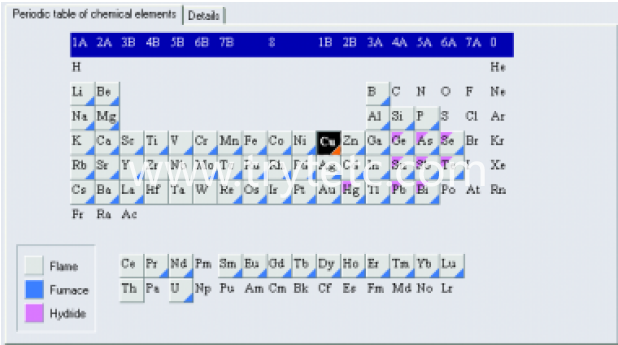
Features’╝Ü
Fully Automated’╝Ü
1. The flame and graphite furnace is integrated into one instrument. The change over from one technique to another is carried out by simple keystrokes within the software.
2. The instruments have a motorized 8 hollow cathode lamp turret which allows the automatic positioning and optimization of each hollow cathode lamp by the software.
3. The control of the gas flows for the fuel gas (C2H2) and the positioning of the burner is also carried out directly from the software thus allowing optimization of the instruments for the best analytical parameters for a selected analysis.
4. Two methods of background correction are available. The first utilizes a deuterium lamp and the second is the proven method of self reversal.
5. The location of the wavelength and peak selection is automatic and controlled from the software.
6. The spectral bandwidth is automated and is available with a choice of five slit sizes
7. The electronic parameters for the photomultiplier detector, the hollow cathode lamp current and the balancing of the absorbance and background energies are controlled from the software.
8. The ignition of the flame is computer controlled and the various safety interlocks offer a very safe operating system.
ADVANCED GRAPHITE FURNACE’╝Ü
1. The unique design of the graphite furnace reduces the chemical interference effects and memory effects by uniformly heating the graphite electrode.
2. The computer controlled heating program allows the user to select the best heating program for the analysis.
3. The optical temperature during the atomisation stage ensures the rapid heating and rapid analysis. This helps to extend the life of the graphite tube and enhances analytical accuracy.
PROVEN SAFETY FEATURES’╝Ü
1. The flame conditions are continuously monitored and should the flow rates change an audible alarm sounds.
2. The pressure of the support gas (oxidant) is monitored constantly. If the pressure changes then the flow of the fuel gas will be stopped and the flame will be safely extinguished.
3. A sensor monitors the level of liquid in the drain and will prevent ignition if too low. The flame will also be extinguished of the level of liquid in the drain changes significantly.
4. The argon pressure for the graphite furnace is constantly monitored and should it change the heating cycle for the graphite electrode will immediately cease and the graphite electrode will be de-energized.
5. Cooling water flow rates for the graphite furnace are also monitored for changes and should changes occur the heating program will cease.
6. If the graphite tube should facture during the heating program the heating will cease.
Elements that can be analyzed with the TR-TCS-02

INNOVATIVE DESIGN OF TR-TCS-02’╝Ü
1. The user friendly software requires a Windows platform and operates within Win95, Win98, Win NT, Win 2000 and WinXP. The system uses a number of software wizards to guide the operator through setting up procedures.
2. The software controls the automatic switch over for the Hollow Cathode Lamps and automatically optimizes working parameters for the system. The software also allows manual input of data to ensure that the operator always stays in control. The software will automatically complete the configuration of the system for analysis.
3. The user has the choice of two methods of background correction namely the self reversal system OR the traditional deuterium lamp background correction system.
4. During the analysis cycle of both the flame and graphite furnace the software shows the entire measurement process. This includes measured values, temperature steps, time etc. all signal and temperature data is stored for future re-call and printout.
5. Detailed reporting and QC control software is included within AAWin allows printout of spectra, standard calibration curves, analysis and signal data. Full printout of operating parameters is also available for user references.
6. The following methods of analysis can be carried out using the ST-AAS-02 system Absorption, emission, graphite furnace analysis, hydride and cold vapor analysis.
Specifications’╝Ü
Optic System
Wavelength Range: 190nm - 900nm
Monochromator: Czerny-Turner configuration
Spectral Bandwidth: 0.1nm, 0.2nm, 0.4nm, 1.0nm, 2.0nm (5 steps. with automatic changeover)
Wavelength Accuracy: 0.25nm
Wavelength Repeatability: 0.15nm
Baseline Stability: 0.005A/30 min
Flame analysis’╝Ü
Sensitivity (Cu): 0.03 ’ā¼g/ml/1%
Burner Head: Titanium alloy burner
Nebulizer: High-efficiency glass nebulizer
Atomization Chamber: Corrosion-resistant material
Position Adjustment: Automatic changeover of flame and furnace
Automatic setting of optimum height for flame burner
Safety: Automatic ignition and of mixing air-acetylene gas with safety control
Graphite furnace analysis’╝Ü
Temperature Range: Ambient - 2650
Heating: Voltage feedback control when drying and ashing;
Optical temperature control when atomizing
Heating program: Up to 9 steps with choices of ramp, temperature increase and full-power heating
Background correction’╝Ü
Deuterium Lamp Background
Correction:
1.0 Abs Self-Reversal Background Correction: 3.0 Abs
Data processing’╝Ü
Analytical method: flame, graphite furnace and hydride
Determination method: calibration curves using 1st, 2nd and 3rd order of fit, standard addition method
Repetitions: 1-20 with calculations of average, SD and RSD
Result Printout: output of parameters, data, spectra and calibration curves
Mainframe’╝Ü
Light Source: 8 hollow cathode lamp turrets with 2 lamps simultaneously lit (one lamp pre-heated)
Power Supply: 110V/60Hz or 220V/50Hz three-phase AC
200W (mainframe) 5000W (graphite furnace)
Dimensions mainframe 110 cm ├Ś 50cm ├Ś 45cm
Graphite furnace 50cm ├Ś 50cm ├Ś 45cm
Software download
AAWin v2.2.rar
Optic System
Wavelength Range: 190nm - 900nm
Monochromator: Czerny-Turner configuration
Spectral Bandwidth: 0.1nm, 0.2nm, 0.4nm, 1.0nm, 2.0nm (5 steps. with automatic changeover)
Wavelength Accuracy: 0.25nm
Wavelength Repeatability: 0.15nm
Baseline Stability: 0.005A/30 min

